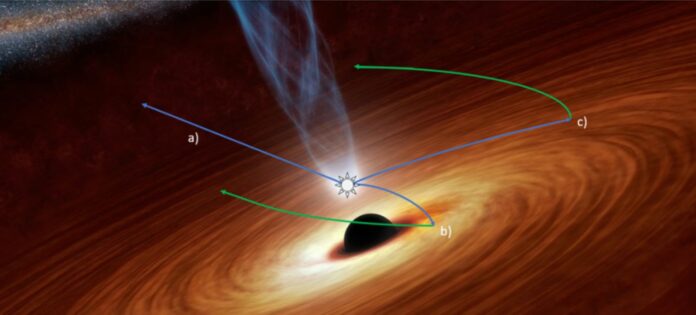The compact remains of stars that died in supernova explosions make up the majority of black holes. They are described as being black because their gravitational field is so intense that not even light can evade it. Nevertheless, the impact on its surroundings can be very visible because the material orbiting a black hole is concentrated into a disc and can heat up significantly. This indicates that they are potent X-ray producers, and many of them also have accompanying jets that eject gas and dust across very long distances.
Most black holes may be located by measuring their X-ray brightness and corresponding estimations of their mass, which are determined by how quickly material orbits them. Scientists in a new study choose a new strategy.
A novel technique to measure the distance to these unusual objects and investigate a mostly unstudied population in the Galaxy’s center is to study for the light jets’ echoes. It might even be used to estimate how quickly the universe is expanding. The method was created by a group at the University of Newcastle and tested on the Cygnus X-1 model black hole.
The disc is illuminated by the black hole jet’s light, which is radiated in all directions. The disc then reflects some incoming light, much like a mirror. As the light emitted in the jet takes longer to reach the outer regions of the disc, it will ripple outward from the disc’s innermost region. This’reverberation’ of light resembles an echo of sound.
In essence, this means we perceive the light coming from the jet in two ways: directly to us and as reflected by the disc. It is feasible to determine how far the jet is above the disc by keeping track of the brightness of the light that comes straight to us and the reflected light. It also reveals to astronomers how near the black hole is to the disc’s inner edge. The disc’s shape changes as one approaches the black hole’s gravitational field.
The researchers can determine the size of the disc and the percentage of light it reflects by jointly measuring the light released from the black hole jet and its surrounding disc. That precisely measures the disc’s brightness and, in turn, the system’s distance from the black hole and disc.
The infrared, visible, and ultraviolet light released from the centers of galaxies (including our own) are often blocked by dense clouds of gas and dust, which limits our view. On the other hand, X-rays can pass through these areas unhindered, making it possible to calculate the distance to supermassive black holes. If it is successful, it will provide a new method for calculating the rate of the universe’s expansion, a question that is still open 94 years after the expansion’s discovery.
It is also a potent instrument for examining the Galaxy’s central population of black holes. Until recently, astronomers tended to focus on relatively light black holes outside the Galaxy’s plane, where most stars are found.
Patrick O’Neill, at the National Astronomy Meeting in Cardiff, said, “This cutting-edge technology offers a method of probing the previously concealed galactic center, offering new insights into the evolution of our own Galaxy and how black holes accrete material[MOU1]. It’s also exciting to think that we could help to establish the rate at which the Universe is expanding – and get a better understanding of its future.”
The group’s current goal is to develop a picture of the black hole population in the Galaxy’s nucleus. This could aid in the discovery of objects like intermediate-mass black holes, which are assumed to be the product of the merger of black holes from single stars and are a precursor to the formation of supermassive black holes, which are enormous and are found at the center of the majority of galaxies.
